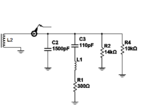asrock70
Full Member level 4
I need to measure the current in the circuit, it may not be entirely accurate, it is rather to determine when the current has reached its maximum.
Parameters
Voltage +- 50V
Current 1-20mA
Frequency 300kHz
Parameters
Voltage +- 50V
Current 1-20mA
Frequency 300kHz
